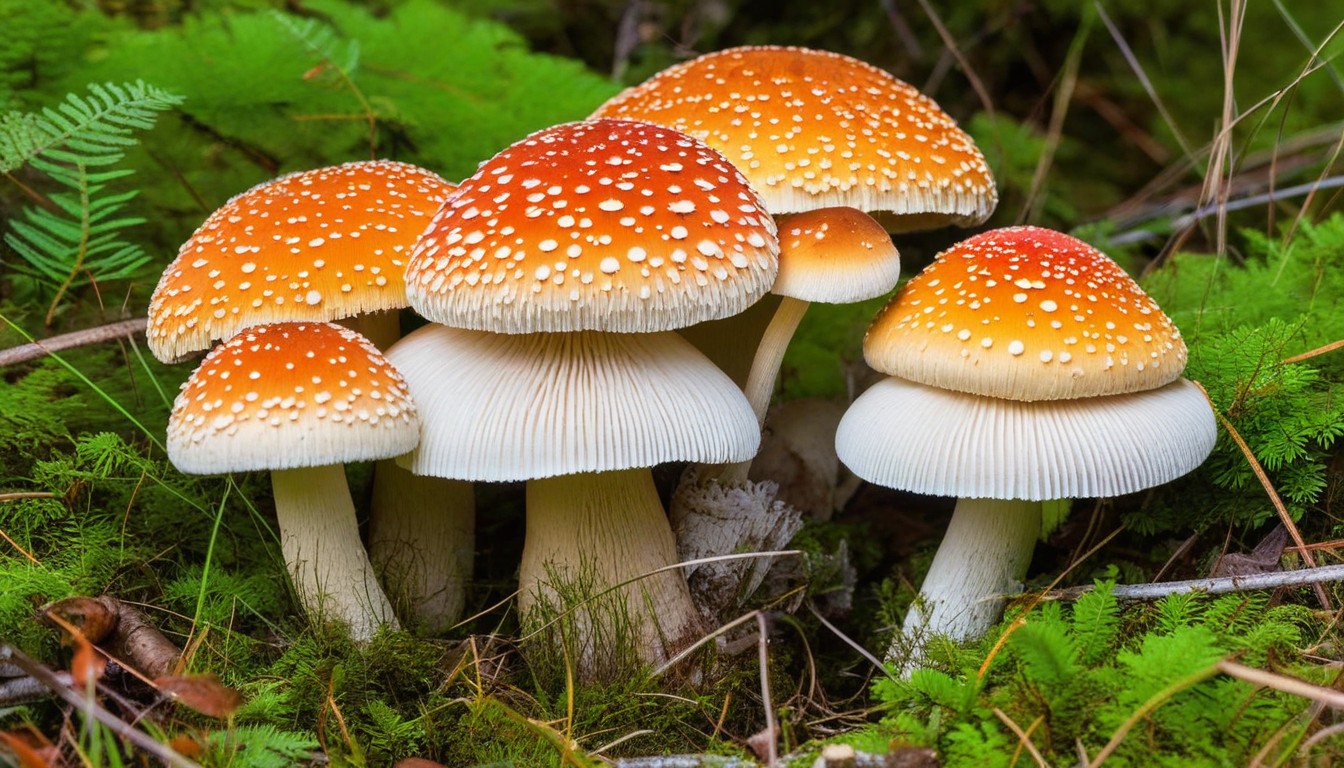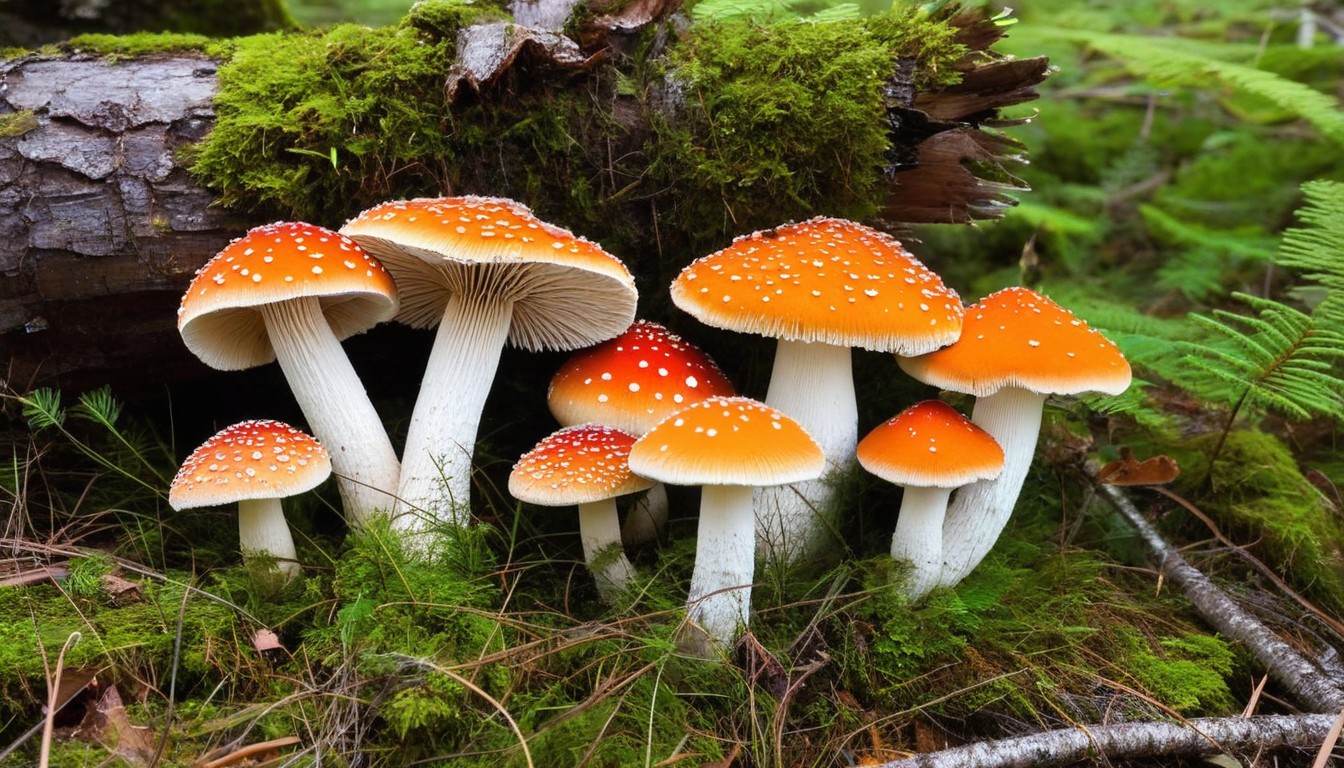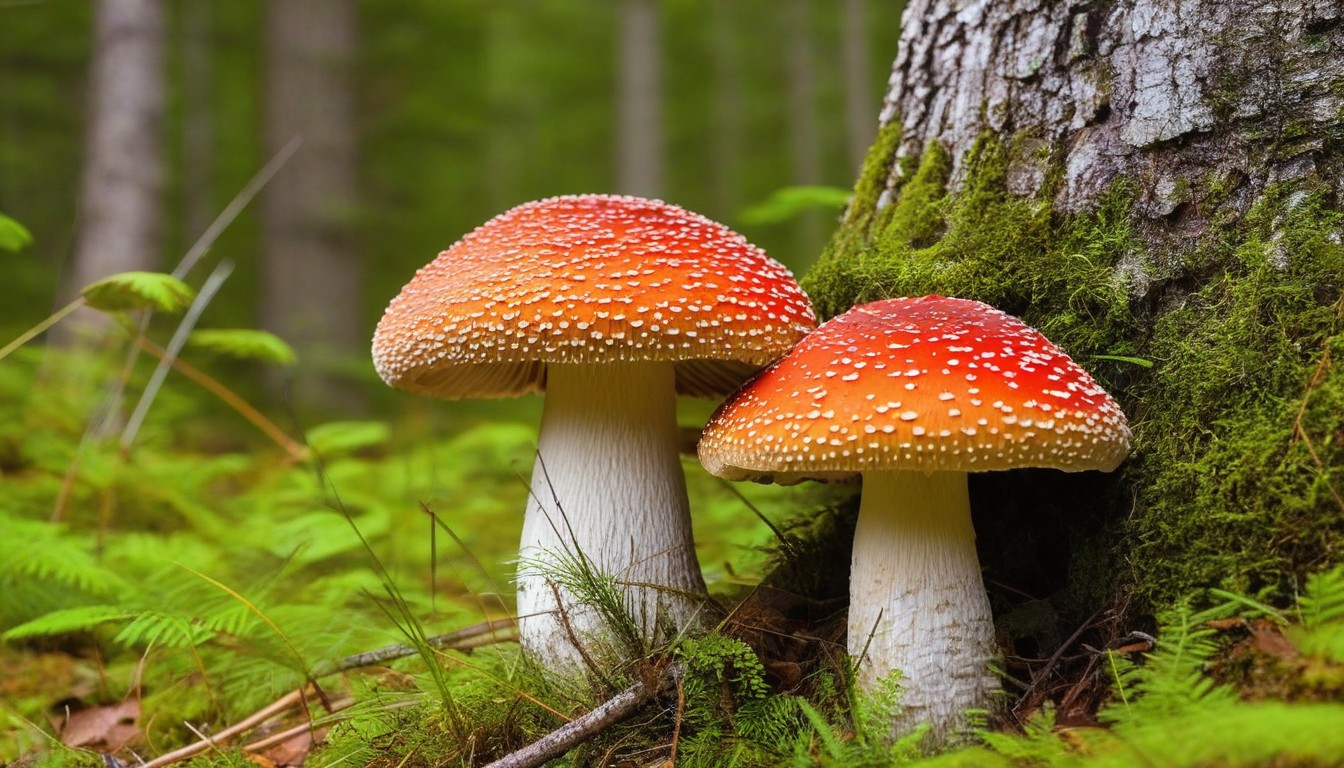Are you fascinated by mushrooms? Do you enjoy exploring the forests of Maine and wonder what types of fungi grow there? If so, you’ve come to the right place. This comprehensive guide will provide you with the knowledge and tools you need to identify the diverse array of mushrooms found in Maine. Whether you’re a seasoned forager or a curious beginner, we’ll help you confidently distinguish between edible and poisonous mushrooms while exploring the wonders of Maine’s forests.
Key Takeaways:
- Learn how to identify the diverse array of mushrooms found in Maine.
- Understand the importance of correctly identifying mushrooms for your safety and the conservation of mushroom ecosystems.
- Explore the common mushroom families found in Maine and their various characteristics.
- Discover essential mushroom identification tools and techniques, including field guides, apps, and key identification characteristics.
- Distinguish between edible and poisonous mushrooms and identify common toxic look-alike species.
The Importance of Mushroom Identification
If you’re interested in foraging, mushroom identification is an essential skill you must possess. Not only does it ensure your safety, but it also contributes to the conservation of mushroom ecosystems. Here are some key reasons why developing your mushroom identification skills is crucial:
- Safety: Incorrectly identifying mushrooms can have severe health consequences, some of which can be fatal. For example, the death cap mushroom (Amanita phalloides) is one of the deadliest mushrooms in the world and can be found in Maine. It closely resembles many edible species and can cause liver failure if ingested.
- Conservation: Understanding which mushrooms are safe to harvest and which should be left untouched ensures the sustainability of mushroom ecosystems. Over-harvesting of certain species can have detrimental effects, leading to a decline in biodiversity and disturbing the balance of the ecosystem.
- Foraging skills: Correctly identifying mushrooms opens up a world of culinary possibilities, allowing you to safely incorporate wild mushrooms into your cooking. In addition, understanding the characteristics of different mushroom species can aid in finding and harvesting them.
In the next section, we’ll take a closer look at the anatomy of a mushroom, which is a crucial step in identifying them accurately.
Mushroom Anatomy: A Closer Look
Before we dive into the diverse world of Maine mushrooms, it’s important to understand their basic anatomy. Each mushroom is composed of several key parts that enable identification.
The cap is the top of the mushroom, which can vary in shape, color, and texture. The stem supports the cap and can also vary in length, thickness, and color. Beneath the cap are the gills, thin and delicate structures that radiate from the center of the cap. Some mushrooms have pores instead of gills, which can be found on the underside of the cap. Lastly, spores are the mushroom’s reproductive cells, which are attached to the gills and released into the air when mature.
Each of these structures provides essential clues for identifying Maine mushrooms. For example, the shape and color of the cap, the pattern of the gills, and the spore print color can all aid identification. Understanding these features will come in handy as you encounter the various mushroom species found in Maine.
Types of Gills
Mushroom gills come in several types, each with a different pattern and shape. Some of the most common types include:
|
Gill Type |
Description |
|---|---|
|
Free Gills |
Gills that extend from the stem and do not attach to it or the cap. |
|
Adnate Gills |
Gills that are attached to the stem but do not extend down to the base. |
|
Attached Gills |
Gills that are attached to both the stem and the cap. |
|
Decurrent Gills |
Gills that extend down the stem. |
Identifying the type of gills, along with their color and spacing, can provide valuable information in identifying Maine mushrooms.
Now that we’ve taken a closer look at mushroom anatomy, the next step is to explore the common mushroom families found in Maine.
Common Mushroom Families in Maine
Maine is home to a diverse array of mushroom families, each with unique characteristics that aid in their identification. Here are some of the most common families you’re likely to encounter while foraging in Maine:
|
Mushroom Family |
Key Characteristics |
Common Examples |
|---|---|---|
|
Agaricaceae |
Cap with gills underneath, typically with a central stem. |
Button mushrooms, meadow mushrooms, fly agarics. |
|
Boletaceae |
Cap with pores underneath, typically with a bulbous stem. |
Boletes, slippery jacks, velvet boletes. |
|
Amanitaceae |
Large cap with white gills, typically with a volva (cup-like structure) at the base of the stem. |
Death caps, destroying angels, fly agarics. |
Of course, these families represent only a fraction of the mushroom species found in Maine. However, by familiarizing yourself with these common families, you’ll be well-equipped to identify many of the mushrooms you’ll come across in the field.
Mushroom Identification Tools and Techniques
Equipping yourself with the right tools and techniques is vital to identify Maine mushrooms effectively. Here are some essential resources that every forager should have:
Field Guides
A reliable field guide is a must-have for any mushroom enthusiast. Look for guides that are specific to Maine mushrooms and include detailed descriptions, photographs, and identification tips. Some popular options include “Mushrooms of the Northeastern United States and Eastern Canada” by Timothy J. Baroni and “Mushrooms of the Northeast” by Peter J. Kibby.
Smartphone Apps
In today’s digital age, many foragers are turning to smartphone apps for mushroom identification. Applications such as “iNaturalist” and “PictureThis” allow you to take a photo of the mushroom and get an instant identification result. However, it’s essential to use these apps as a supplement to your field guide and not rely solely on technology.
Identification Characteristics

Learning to identify specific characteristics of mushrooms can also be helpful in correctly identifying them. These characteristics include the shape of the cap, the color of the gills, and the texture of the stem. Furthermore, spore prints, which are produced by collecting spores from the gills of a mushroom, can also aid in identification.
Pro Tip: Investing in a magnifying glass can help you examine mushrooms’ tiny details and aid in your identification efforts.
By utilizing these tools and techniques, you can enhance your foraging skills and confidently identify Maine mushrooms.
Edible vs. Poisonous Mushrooms in Maine
Distinguishing between edible and poisonous mushrooms is a critical skill every forager should possess. While Maine has a variety of delicious mushrooms, it is important to know which can cause harm if consumed. Below are some common edible mushrooms found in Maine, as well as dangerous species to avoid:
Edible Mushrooms in Maine
Some of the most popular edible mushrooms in Maine include:
|
Mushroom |
Description |
Preferred Habitat |
Season |
|---|---|---|---|
|
Chanterelle |
Yellow or orange, with a distinctive funnel shape and ridges, a fruity aroma, and a delicate flavor. |
Deciduous forests, but they can also be found in mixed coniferous-deciduous forests, or even in meadows or along roadsides with oak or pine trees. |
Summer to fall |
|
Black Trumpet |
Small and trumpet-shaped, with a wavy margin and a black, brown, or gray color. |
Deciduous forests, often growing in association with oaks or beech trees. |
Summer to fall |
|
Maitake |
A large, irregularly shaped mushroom with a gray-brown cap and white flesh. |
Found at the base of trees, such as oak and maple. |
Summer to fall |
Poisonous Mushrooms in Maine
Several mushroom species can cause severe or even deadly poisoning if consumed. Some of the most hazardous mushrooms to avoid in Maine include:
- Amanita phalloides, also known as the “death cap,” has a light greenish-gray cap and white gills.
- Amanita muscaria, or the red-and-white “fly agaric” mushroom, has a distinctively spotted cap and grows in coniferous forests.
- Galerina marginata, commonly known as the “autumn skullcap,” has a brownish-yellow cap and a ring of tissue around the stem.
It’s important to remember that identifying mushrooms can be challenging, and novice foragers should never consume a mushroom unless they are 100% certain of its identification. Always consult with an expert or experienced forager if in doubt.
Unique and Rare Maine Mushrooms
Maine’s diverse ecosystems offer the perfect habitat for a wide variety of mushroom species. From the enchanting red-capped Amanita muscaria to the tiny and delicate Mycena leptocephala, here are some of the unique and rare mushrooms you might encounter while foraging in Maine.
|
Mushroom Name |
Description |
Image |
|---|---|---|
|
Hydnellum peckii |
A rare, toothed mushroom commonly known as the “bleeding tooth fungus” due to the red fluid that oozes from its pores when squeezed. |
 |
|
Entoloma abortivum |
A fascinating mushroom that can take on two distinct forms – as a typical cap and stem, or as a mushroom with a convoluted, lobed shape known as the “false truffle.” |
 |
|
Cantharellus cibarius |
Also known as the chanterelle, this golden-yellow mushroom is highly prized by chefs for its delicate, apricot-like flavor. |
 |
|
Grifola frondosa |
A large, frilly mushroom commonly known as the “hen of the woods” for its resemblance to a fluffed-up chicken. It has a nutty, slightly sweet flavor and is a popular ingredient in soups and stews. |
 |
These are just a few examples of the unique and rare mushrooms you might come across while exploring the forests of Maine. Remember to always practice safe foraging techniques and enjoy the wonders of Maine mushrooms identification!
Habitat and Seasonal Patterns of Maine Mushrooms

Identifying a mushroom’s preferred habitat and seasonal patterns is essential for successful foraging in Maine. To help you in your search for the perfect mushroom, we’ve compiled a list of common habitats and seasons where various mushroom families can be found.
Mushroom Habitats in Maine
Maine’s diverse landscape boasts a variety of mushroom habitats, from the forests to the meadows and even the coast. Below are some of the most common habitats where you’re likely to find Maine mushrooms:
|
Habitat |
Mushroom Families |
|---|---|
|
Coniferous Forests |
Boletaceae, Russulaceae, Amanitaceae |
|
Deciduous Forests |
Agaricaceae, Polyporaceae, Chanterellaceae |
|
Meadows |
Agaricaceae, Russulaceae, Hygrophoraceae |
|
Coastal Areas |
Agaricaceae, Boletaceae, Polyporaceae |
Keep in mind that mushrooms can also be found in unexpected places, such as on dead wood, buried underground, or even growing on other fungi.
Seasonal Patterns of Maine Mushrooms
The season and weather conditions can also greatly impact mushroom growth and availability. Here are the seasons when you’re most likely to find various mushroom families in Maine:
- Spring: Morel mushrooms, chanterelles, and oyster mushrooms
- Summer: Boletes, Russulas, and coral mushrooms
- Fall: Agaricus, amanitas, and honey mushrooms
- Winter: Some species of polypores and other shelf fungi
Keep in mind that weather conditions, such as rainfall and temperature, can affect the timing and growth of mushrooms, so it’s always best to keep an eye out for new growth throughout the seasons.
Toxic Look-Alike Mushrooms in Maine
As a forager, it’s essential to understand the difference between toxic mushrooms and their look-alikes. While some edible mushrooms have poisonous doppelgangers, others have no safe substitutes and must be identified with utmost care. In Maine, there are several species to watch out for, including:
|
Mushroom Name |
Toxicity |
Similar Look-Alikes |
|---|---|---|
|
False Morel (Gyromitra esculenta) |
Deadly Poisonous |
|
|
Destroying Angel (Amanita bisporigera) |
Deadly Poisonous |
|
|
Jack O’Lantern (Omphalotus illudens) |
Poisonous |
|
It’s crucial to note that these mushrooms are only a few of the many toxic look-alikes found in Maine. Always double-check your identification and use multiple resources to confirm the safety of a mushroom before consuming it. When in doubt, it’s best to err on the side of caution and leave the mushroom in the wild.
Remember, when in doubt, throw it out!
Ethical Foraging Practices

When it comes to foraging for Maine mushrooms, it’s important to practice ethical behavior to ensure the preservation of the mushroom ecosystems. Here are some ethical foraging practices to keep in mind:
1. Practice Sustainable Harvesting Techniques
To ensure that you leave enough mushrooms behind for others and for the ecosystem itself, don’t harvest more than you need. Additionally, avoid picking immature or small mushrooms, as they haven’t yet had the chance to release their spores and propagate.
2. Respect Property Rights
Always obtain permission before foraging on private property, and respect any rules or regulations in public areas.
3. Use Proper Tools and Techniques
Avoid using rakes or other tools that can damage the mushroom’s mycelial network, which can negatively impact the ecosystem. Instead, use a sharp knife to carefully detach the mushroom from its stem. Additionally, avoid pulling up the entire mushroom, leaving the stem base intact to allow for regrowth.
4. Leave No Trace
Dispose of any trash properly and be sure to leave the foraging area as you found it. Avoid trampling plants or disrupting natural habitats.
5. Take a Foraging Workshop
Consider taking a foraging workshop or class to gain additional knowledge on ethical foraging practices and mushroom identification. You’ll learn about the importance of preserving the ecosystem, and you’ll discover new techniques to help you forage in an ethical and sustainable way.
By following these ethical foraging practices, you’ll ensure that Maine’s mushroom populations remain healthy and abundant for generations to come.
Conclusion
Exploring the world of Maine mushroom identification is an exhilarating adventure that provides endless wonder and satisfaction. Whether you’re a seasoned forager or a curious beginner, the journey promises to be rewarding. By developing your identification skills, you will become adept at distinguishing the different types of mushrooms found in Maine.
Remember, identifying mushrooms is crucial for your safety and the conservation of mushroom ecosystems. Don’t forget to equip yourself with the essential tools and techniques that will enhance your identification abilities and keep you safe.
Start Your Journey Today!
The incredible biodiversity found in Maine’s eastern forests makes it a perfect location for mushroom foraging. Venture out into the woods and discover the unique and rare mushrooms that New England has to offer.
Lastly, ethical foraging practices are essential for preserving Maine’s mushroom ecosystems. Ensure that you are following sustainable harvesting techniques and leaving no trace principles during your mushroom foraging adventures.
So, what are you waiting for? Start your journey into Maine’s mushroom identification today, and you’ll unlock the wonders of this incredible fungi!
FAQ
Why is mushroom identification important?
Mushroom identification is crucial for your safety and the conservation of mushroom ecosystems. It helps you distinguish between edible and poisonous mushrooms, ensuring you only consume safe species.
How can I identify mushrooms in Maine?
You can identify mushrooms in Maine by studying their anatomy, understanding common mushroom families, using identification tools and techniques, and familiarizing yourself with habitat and seasonal patterns.
Are all mushrooms in Maine edible?
No, not all mushrooms in Maine are edible. Some species can be highly toxic. It’s important to accurately identify mushrooms before consuming them to avoid any health risks.
Are there any unique or rare mushrooms in Maine?
Yes, Maine is home to unique and rare mushrooms. Its exceptional biodiversity ensures you might encounter some extraordinary species while exploring the forests of Maine.
What are some resources for mushroom identification in Maine?
Some resources for mushroom identification in Maine include field guides, smartphone apps, and online databases. These tools can help you identify mushrooms based on their physical characteristics.
How can I forage for mushrooms ethically?
Ethical foraging practices involve sustainable harvesting techniques, leaving no trace principles, and respecting the ecosystems where mushrooms grow. It’s important to avoid over-harvesting and damaging habitats.

